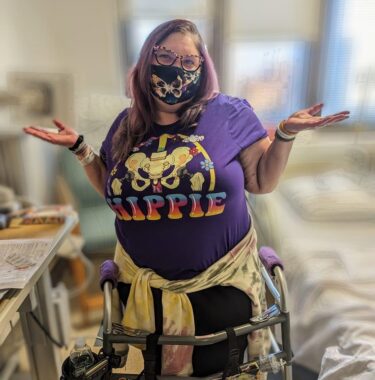How a hip replacement brought me happiness and hope
The procedure brought relief from avascular necrosis symptoms

When I told my primary physician a few months ago that I was diagnosed with avascular necrosis (also known as AVN or osteonecrosis) and would be having a total hip replacement in early June, he offered his sympathies. I understood that inclination, but I was thrilled. I would have jumped for joy, but I could barely walk. I did, however, cry tears of joy when my orthopedic surgeon gave me the news.
It may seem strange to rejoice about a serious condition like this, but just as it was a relief to be diagnosed with sarcoidosis after a years-long search for answers, this surgery was the step I needed to begin the path toward substantial physical relief. It was the step I’d been hoping to take for a year and a half, but three previous orthopedic surgeons had turned me away.
Getting hip to the problem
I was first told I’d need a hip replacement in late 2021, but the orthopedist simply said, “Not yet.” He assured me that my hip would undoubtedly get worse, but explained that I had to wait until I “couldn’t take it anymore” before we could take that step. I thought I was already at that point, as I’d been dealing with increased pain and decreased mobility for over five years.
As far back as 2016, my rheumatologist suggested that I might have AVN — a condition involving the degeneration of bone tissue due to lack of blood or oxygen, often brought on by long-term steroid use — but soon moved on to other diagnoses and other treatments. While some provided temporary relief, the pain always returned, intensified. And with multisystem conditions like sarcoidosis, dysautonomia, rheumatoid arthritis, and more, other symptoms competed for the spotlight.
While we focused on those other areas, my hip continued to deteriorate. Musculoskeletal sarcoidosis, sometimes referred to as sarcoid arthritis or sarcoid arthropathy, contributed to years of inflammation, pressure, and pain. And while steroids — the go-to treatment for sarcoidosis and arthritis — were tremendously helpful in some ways, they also led to weight gain and weakened bones — a dangerous combination.

Kerry Wong prepares to leave the hospital last month as a happy hippie with a new hip. (Courtesy of Kerry Wong)
One happy hippie
It’s been about a month since the surgery, and I’m loving this road to recovery. I’m still surprised every day that I don’t have that sharp, stop-you-in-your-tracks agony when I try to move. I still can’t believe it no longer feels like my leg is stuck, pinching the nerves and connective tissue and sending me into a panic when I have to move but can’t.
While this process may seem normal to most healthy people, the whole concept is so strange to me. The idea of “getting better” is something I put out of my mind years ago. It’s like when my doctor said I was in remission after a clear chest X-ray; with so many chronic illnesses that have no cure and limited treatments, I’ve resolved myself to always being sick and in pain.
But I’ve made so much progress in just a few weeks. Naturally, I’m still sore as my body adapts to its new parts and the work I’ve been doing with physical and occupational therapy. But even that is easing up. I can see — and feel — that I’m moving a little easier every day. And I’m just getting started!
My belief, my hope, and my plan is that this will have a domino effect on my health. Now that I’m no longer on steroids and as I regain the ability to exercise again, I should be able to lose some of the weight I’ve gained. Though my weight didn’t cause these problems, I know it exacerbates them, so with weight loss, some of my symptoms may ease up as well. That can circle back again, as the decrease in pain and fatigue allow me to be more active, and so on.
Of course, it’s important to remain realistic about the situation. While a ceramic and titanium hip can make me stronger and more agile than I’ve felt in years, it isn’t made to last forever. I may need to replace it again in a decade or two — not to mention any other arthritic joints that may want to join the party.
Beyond that, I’m still living with autonomic dysfunction, fibromyalgia, migraine, neuropathy, and of course, sarcoidosis. While their impact may wax and wane at any given moment, none of them has a cure, so they will be with me for life. But I’m grateful for the difference I’m already seeing from this surgery, and the hope that it’s given me.
So to paraphrase a famous lyric from Jay-Z: “I’ve got 99 problems, but a hip ain’t one.”
Note: Sarcoidosis News is strictly a news and information website about the disease. It does not provide medical advice, diagnosis, or treatment. This content is not intended to be a substitute for professional medical advice, diagnosis, or treatment. Always seek the advice of your physician or other qualified health provider with any questions you may have regarding a medical condition. Never disregard professional medical advice or delay in seeking it because of something you have read on this website. The opinions expressed in this column are not those of Sarcoidosis News or its parent company, Bionews, and are intended to spark discussion about issues pertaining to sarcoidosis.








Leave a comment
Fill in the required fields to post. Your email address will not be published.